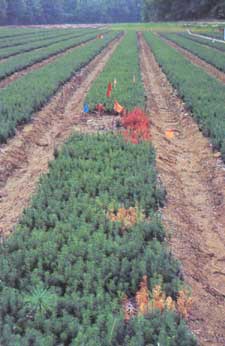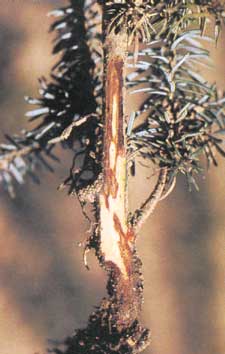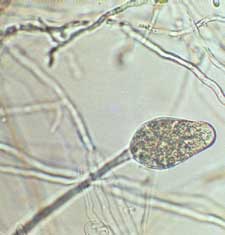Phytophthora Root Rot of ConifersE. George Kuhlman - Principal Plant Pathologist, Southeastern Forest Experiment Station, USDA Forest Service, Athens, GA, Cordell C.E., Anderson R.L., Hoffard W.H., Landis T.D., Smith R.S. Jr., Toko H.V., 1989. Forest Nursery Pests. USDA Forest Service, Agriculture Handbook No. 680, 184 pp. Hosts Phytophthora root rot of conifers, caused by fungi of the genus Phytophthora, affects many species of fir, true cedars, white-cedar, larch, pine, spruce, yew, and Douglas-fir. In nurseries, Douglas-fir, Fraser fir, and red pine are frequent hosts. Distribution Phytophthora species are common pathogens in wet, poorly drained nursery soils throughout the United States. Phytophthora cinnamomi is most destructive in warmer areas, whereas P. cryptogea, P. megasperma, and other species predominate In the cooler areas of the Pacific Northwest. More than one species may be present In a nursery. Damage Some nurseries have had to be abandoned because of mortality caused by Phytophthora. In addition to causing mortality and cull, the disease can greatly reduce the rate of survival of outplanted stock. Diagnosis Look for wilting, stunted foliage, chlorosis, and eventually death of seedlings (fig. 16-1), especially in low, wet areas. The cambium of infected seedlings is red-brown or butterscotch colored particularly at the root collar, contrasted with the white cambium of the healthy stem (fig. 16-2). Also look for dead, black, fine feeder roots. Phytophthora produces no easily recognizable fruiting bodies or spores on infected tissue, and diagnosis can be confirmed only through isolating the organism into pure culture. Phytophthora species are often difficult to isolate because they are frequently overgrown by other fungi, especially Pythium species. For this reason, selective media are often used. Live symptomatic seedlings with active lesions should be collected and kept cool and moist until isolations can be attempted. Slow-growing, white, coenocytic mycelium is characteristic of Phytophthora. The various species are separated on the basis of hyphal morphology, production of oospores or chlamydospores, or shape and size of sporangia. Identification of species is usually left to specialists. Biology
Control Prevention - Select nursery sites with well-drained soils. Phytophthora root rot in nurseries can be greatly reduced by improving soil drainage and limiting irrigation. Do not transplant seedlings from infested nurseries into disease-free ones. Avoid using diseased trees for mulch because chlamydospores or oospores may survive in this host material for several years. Avoid movement of equipment between infested and noninfested areas. Diseased seedlings should be lifted separately and destroyed by fumigation or burning. Any effort to save healthy looking trees within diseased areas will result in the spread of the fungus to other areas of the nursery and to outplantings. After working in infested areas, clean equipment thoroughly with steam or an equivalent method. Chemical - Fumigate soil with methyl bromide and chloropicrin mixture to reduce damage. Unfortunately, fumigant penetration in heavy soils is often inadequate. Metalaxyl, a selective systemic fungicide, is registered as a seed-bed soil drench for seedlings of Fraser fir and Douglas-fir. Two annual applications of metalaxyl are effective in controlling Phytophthora root rot. Selected References Bruck, R.I.; Kennerly. C.N. 1983. Effects of metalaxyl on Phytophthora cinnamomi root rot of Abies fraseri. Plant Disease. 67: 688-690. Cooley. Sally J.; Hamm. Philip B.; Hansen, Everett M. 1985. Management guide to phytophthora root rot in bareroot conifer nurseries of the Pacific Northwest. Portland, OR: U.S. Department of Agriculture. Forest Service, Pacific Northwest Region. 14 p. Hansen, EM.; Hamm, PB.; Julis, A.J.; Roth. LF. 1979. Isolation, incidence, and management of Phytophthora in forest tree nurseries in the Pacific Northwest. Plant Disease Reporter. 63(7): 607-611. Thorn. WA; Zentmyer, &A. 1954. Hosts of Phytophthora cinnamomi Rands. Plant Disease Reporter. 38: 47-52. |
Forest Pests: Insects, Diseases & Other Damage Agents |

|
|




